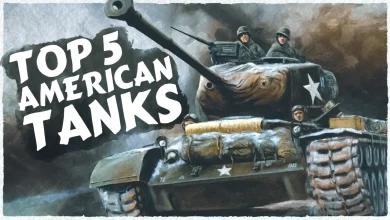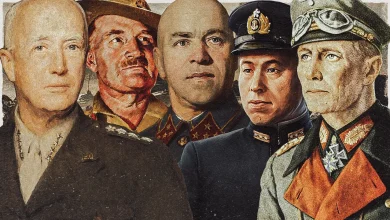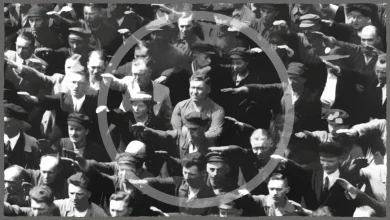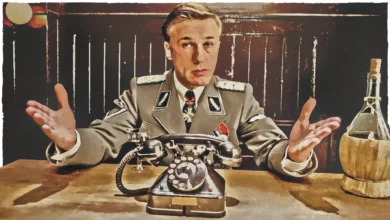Battle of Lanzerath Ridge – 18-man I&R platoon vs. 500 German paratroopers

On December 16 of 1944, 18 American soldiers from a reconnaissance platoon faced off against a German advance, outnumbered 27-to-one in what would come to be known as the Battle of Lanzerath Ridge. The day-long confrontation saw the 18 soldiers battle 500 German paratroopers with such ferocity that the German believed a massive American fighting force must be waiting for them in the nearby woods. The deception would prove vital as the platoon delayed the entire 1st SS Panzer Division for nearly 20 hours and set the stage for the Allies to win a decisive victory at the Battle of the Bulge…
Battle of the Bulge
Battle of the Bulge was the last German offensive on the Western Front of World War II, lasting from December 16, 1944, to January 25th, 1945. The attacks were carried out in the woods of eastern Belgium to block Allied access to the port of Antwerp. The Germans hoped the audacious move would allow them to encircle and defeat all four enemy armies, forcing the Allies into a peace treaty beneficial to the Axis powers.

The Battle of Lanzerath Ridge took place over one day, on December 16th, 1944, and has been recognized as one of the first altercations of the greater Battle of the Bulge. It took place near Lanzerath, a Belgian village, along the trail pursued by the German northern shoulder advance.
Before the battle, the U.S. Army had been attacking the German Ruhr River dams. After succeeding and breaking the German fortified lines, they expected a counter-attack. Still, American intelligence failed to discern the hundreds of armored vehicles going their way and the thousands of soldiers about to attack.
The border area between Germany and Belgium was often called a Ghost Front. Despite the quiet, however, the region held a vital network in the Losheim Gap, a narrow five-mile-long valley. It was here that the Germans plan to use to send their 5th and 6th Panzer armies for a major offensive.
The 394th
The 18 American troops in the 394th Intelligence and Reconnaissance Platoon were well-trained but mostly inexperienced soldiers deployed to the Ardennes. Some of them were college-educated graduates of the by-then defunct Army Specialized Training Program which trained future personnel and engineering, foreign languages, or medicine.
The platoon was commanded by one of the youngest operators in the entire army, 20-year-old Lieutenant Lyle Bouck.

The platoon was formed by two reconnaissance squads of 9 men each. While highly trained for surveillance efforts, they were not prepared nor intended to directly engage with the Germans.
Their main objective was to serve as a special intelligence agency for the regiment commander by collecting information and providing it to the regimental intelligence officer, such as the coordinates and size of the enemy forces. To do this, they operated patrol vehicles, and observation posts, and coordinated intelligence activities across the regiment.
They’ve been living in the basement of a brick building in Hünningen, which used to store the combat rations of the military.
On the morning of December 16th, the two squadrons detected a significant German advance in the next town but their communications were largely cut off from the higher headquarters and they had no additional support.
At the time the majority of the American forces in the area were attacking the Siegfried Line through Walerscheid, five miles north of where the platoon was. Although they expected a counter-attack, they were not expecting as great of a force as the Germans were sending their way.
Lieutenant Bouck and his team decided to build fortifications at Lanzerath, on a hilltop edge of the forest overlooking pasture. They used foxholes left behind by a previous unit, but they dug deeper so that at least two or three more soldiers could fire from within while hidden. Each hole was then covered with pine logs, their position gave them control over 300 yards of the ridge line to the northeast and allowed them to cover the fork in the road to their left.

As it snowed, the Americans were made invisible to those who would soon travel the road below. They used a nearby log hut as a warming hut. They brought along the four additional carbines, two automatic rifles, and a light machine gun that Bouck add it to the unit’s arsenal. They also counted on a .50 caliber machine gun atop of jeep obtained by Bouck through backchannels. The platoon dug an emplacement for the jeep, placing it in an advantageous position to the road.
They ran a jeep patrol each hour to maintain contact between their left and right flank units and to continue surveilling the enemy’s movement. The team meant to serve as the eyes and ears of the 394th Infantry Regiment was forced into a combatant position which they were relatively unprepared for. The only direct order they received was to hold the area at all costs. Yet they expected to receive support and remained hopeful that their situation would change.
Bouck would later state in an interview with CNN: “We weren’t trained to occupy a defensive position in the front lines. We were trained to patrol and get information about the enemy.”
The 3rd Fallschirmjäger
By that point in the war, most German units were formed by a combination of sprinkled seasoned veterans and a crew of untested young Germans who had rarely ever shot a gun before.
During the invasion of Normandy, the Germans’ 3rd Fallschirmjäger Division known for its effectiveness in combat was mostly vanquished. To keep German morale, it had been rebuilt with members from the Luftwaffe field regiments.
They carried the new StG 44 selective-fire rifle and rifle grenades and were generally well-armed. Yet the new recruits were still green and under the impression that the American soldiers were highly demoralized and unwilling to put up a fight.
From this new 3rd Fallschirmjäger Division, the 9th Regiment was ordered to head the attack on Lanzerath and wiped the village clean. They would then attack Honsfield and Bullingen where they believed they would face the bulk of the U.S. troops.
The 6th Panzer Army headed by Kampfgruppe Peiper would continue immediately towards the right flank to attack the route by Losheimergraben directly after Lanzerath was taken.

The German forces on their way to meet the small American platoon included 500 men in the 9th Fallschirmjäger Regiment and 50 men from the Fusilier Regiment. Despite Germany’s recent losses and the encroachment of the Allied forces on their territory, their morale was strong. They saw their line as the ultimate defense of their homeland.
The Battle of Lanzerath Ridge
The attack began with a two-hour-long rolling barrage. Thanks to the foxholes, the I&R platoon was mostly unharmed. Unfortunately for them, the German soldiers cut their landlines without the possibility of asking for backup.
By radio, the regiment was ordered to hold the area and send a patrol. The patrol watched if the large German unit emerged, intending to march through the town on the road in front of the hill with foxholes, eventually taking them to the unprotected flank of the regiment. Upon return, the patrol wanted to withdraw, but Lieutenant Bouck ordered the soldiers to remain in their foxholes as he hoped that their defensive strategy might stall the German army.
The battle began without initial fire. The Germans rolled in with their commanders out in the open, perfectly positioned for the platoon to take out. Yet a young civilian girl reportedly left her house to warn them of the presence of the Americans.
The German soldiers used roadside ditches to hide and shoot while the Americans shot back from the foxholes. The Germans tried to attack the platoon from the front, but they had little at which to aim. The snow had rendered the platoon invisible, the defensive positions of the Americans was far superior, and the Fallschirmjäger Regiment bore the devastating effects of it.
Back and forth shooting between the 18 men and the group of over 500 lasted all day. Three concerted assaults were launched against the defensive position, and 394th Intelligence and Reconnaissance Platoon defeated each one. German paratroopers charged in waves with little efficacy.
Lieutenant Bouck was set on fighting to the very last bullet to stall the Germans. Yet they were not only threatened by the paratroopers present but by the 1st SS Panzer Division coming up behind them. Eventually, the enemy fire destroyed the I&R Platoon’s radio, ending all their communication with the outside world.
Hundreds of Germans had fallen on the snow by the time the third wave of attacks was over with only one American soldier wounded. Despite their early success, they knew that they couldn’t hold a defensive position for much longer.
Bouck later stated in an interview with The New York Times: ”We were frightened and we were tired and it was like a hellish nightmare. It seemed it would never end. We couldn’t get any help. It seemed like it was all hopeless.”
The soldiers had been fighting on little or no sleep. They were freezing, and they were running out of munitions. Lieutenant Bouck sought reinforcements, a sort of formal withdrawal order by sending two soldiers to the regimental headquarters. They never made it. The Germans captured them.
Prisoners of War
Lieutenant Bouck was planning a withdrawal without consent from his superiors, as his men ran out of ammo, but he never got to put his plan into action.
As night fell on December 16th, 50 of the German paratroopers flanked the platoon and entered its perimeter. They cleaned out each foxhole on their way, capturing the American soldiers.
Lieutenant Bouck was injured in the leg, by a German soldier who fired at his foxhole. Only one of the American soldiers was lost, in action. Once they were all captured, the German paratroopers searched the woods for the humiliating revelation they’d been delayed by a tiny platoon.

German Lieutenant Peiper arrived at midnight, infuriated and frustrated by the delays resulting from the defense, mounted by the I&R platoon as well as the terrible weather.
These delays presented a significant problem for the tight timetable plan for the panzer units, which granted the U.S. Army highly-valuable hours to prepare for the German attack.
Reinforced, the U.S. Army was able to defeat the German units on the northern shoulder of the Bulge. The German army was forced to shift its focus towards the south by means of its 5th Army for the remainder of the conflict.
Lieutenant Bouck turned 21 on December 17th while captive at Café Scholzen. The 17 platoon members were transported to multiple locations before being imprisoned at Stalag XIII-C in Hammelberg, a prisoner of war camp built on the old party rally grounds.
The officers were sent to Oflag XIII-B instead in Hammelberg. The second camp had been built to hold 300 people but instead held over 1,500 at the time of its liberation. The platoon members were liberated at the end of the war.
Recognition
The men at the I&R platoon would become not only the most decorated at the Battle of the Bulge but in World War II. The son of President Eisenhower, John S.D. Eisenhower who commanded the Allied forces in Europe, credited their efforts with blocking an attack that could have resulted in the early destruction of the American position along the front lines. He believed that they receive credit for the way the whole battle turned out.
They were not awarded immediately after the war but a petition to Congress successfully granted them four Distinguished Service Crosses, five Silver Star medals, and Bronze Star medals for the remaining nine soldiers.



